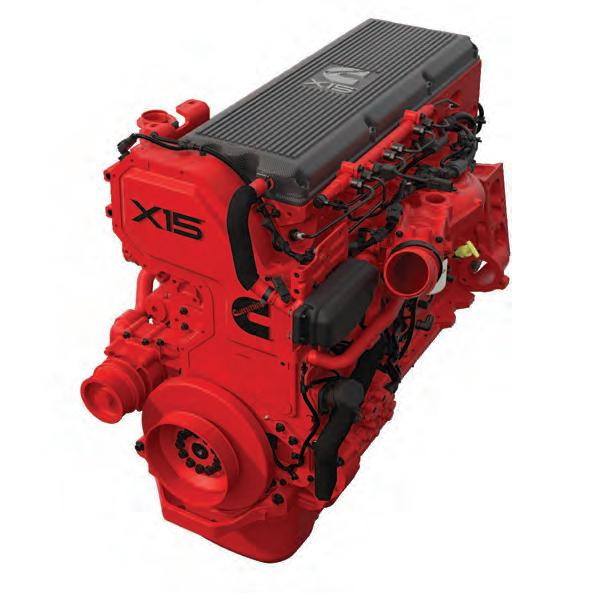
8 minute read
CUMMINS’ ZERO EMISSIONS ROAD MAP
CUMMINS’

ZERO EMISSIONS ROAD MAP
A major global engineering powerhouse like Cummins has been reassessing long term plans in reaction to the impending climate crisis for many years. Mike Fowler, Cummins Director and General Manager On Highway Asia Pacific talks to PowerTorque and explains Cummins’ zero emissions road map to get the company to carbon neutrality by 2050.
Cummins’ Destination Zero strategy outlines the company’s vision for achieving a zero-emissions future. The recently announced strategy is looking for the engine maker to go further and faster to reduce the greenhouse gas and air quality impacts of its products and reach zero emissions by 2050 in a way that is best for Cummins and all stakeholders.
“On the path to zero emissions, we want to remind the industry that it’s a path to zero emission, it’s not a light switch event,” says Mike Fowler, Cummins Director and General Manager On Highway Asia Pacific. “The plan is to minimise carbon emissions over the period between now and 2050. Waiting for vehicles which create zero emissions actually yields a worse carbon footprint over time than adopting a path to zero which has near-term wins in it.”
Cummins is already well down the track of creating better drivelines with lower fuel consumption, automation, down-speeding, renewable fuels etc. This is part of a long term stageby-stage strategy by Cummins to ensure that the product the company sells, from today, reduces carbon emissions as technology becomes available and viable.
As Cummins is outlining its road map forward and continuing its tradition of innovation, there are 11,000

Mike Fowler, Cummins Director and General Manager On Highway Asia Pacific.
engineers in the global organisation working away on moving the technology, step-by-step to that zero carbon target.
According to Cummins, it has done the maths and calculated that by going down the lower emissions path right now, the amount of carbon put into the atmosphere between now and 2050 is lower than if we wait for zero emission technology to come along and save the day.

THE GOAL IS CALLED DESTINATION ZERO To reach zero carbon emissions technology needs to come up with affordable and flexible fuel cell technology and high capacity and affordable battery technology. However, there is also a need to maximise the reduction in greenhouse gas emissions from internal combustion engines (ICE) during the period in the lead up to the newer zero emission technology coming on stream.
From Cummins point of view the low carbon fuels available of today (such as biodiesel, renewable natural gas and hydro-treated vegetable oil) are a cost-effective means to reduce carbon emissions in the field with immediate benefits and without requiring infrastructure changes to the transportation system or without substantially increasing demand on the electrical grid.
“Getting to the goal of zero emissions in 2050 does require changes in our product planning today, rather than waiting for the commercialisation of fuel cell or battery electric technology,” says Mike. “When we talk about emissions now it’s a little more complicated. We have regulated emissions like those included in things like Euro 6 and the US EPA rules. They still need to be met, because those gaseous emissions are harmful and have negative public health impacts.
“However, specific greenhouse gases, CO2, methane, nitrous oxide and others are causing this climate crisis. To decarbonise emissions from transport, all involved have to be involved on the road to zero. There is a need to innovate in the low carbon fuels sector, decarbonise the electricity grid, develop and
Tom Linebarger, Chairman and CEO, Cummins.
scale up a green hydrogen industry on the supply side.”
LOOKING FORWARD The development between now and viable zero emissions technology becoming common in heavy duty applications is going to be a considerable time. This means lower emissions trucks using ICE need to reduce their carbon footprint to help with the overall reduction in carbon emissions.
“A good path to zero emissions has to lower emissions today in the lead up to 2030,” says Mike. “Whatever technology you develop today has to have the capacity to drive wide spread customer adoption as well as reducing well-towork or well-to wheel emissions.”
If the world moves over to battery electric trucks, but the power grid remains coal powered there has been no improvement. From the point of view of an operation like Cummins, there is a need to reduce particulate matter and nitrogen oxides as well and carbon emission in this decade.
The path from current product to the final goal involves a number of smaller steps, each delivering a better carbon outcome. The next stage in the future is the delivery of a new engine platform which will enable the lower emissions technology and fuel to deliver the results required.
It is on this platform that Cummins will be able to move forward in a number of stages, from the current CUMMINS AND ISUZU MEDIUM DUTY COLLABORATION
One of the examples of Cummins’ long term plan, and part of the Destination Zero project is the agreement Cummins and Isuzu announced for a global mid-range diesel powertrain and an advanced engineering collaboration.
This marks another step forward in the Isuzu Cummins Powertrain Partnership (ICPP), which was agreed in May 2019, and formalised a business structure for the two companies to evaluate and carry out opportunities to jointly develop and bring new diesel and alternate powertrains to global markets. “We are pleased to take another step forward in the partnership by powering Isuzu vehicles with Cummins engines in global markets,” said Tom Linebarger, Chairman and CEO, Cummins at the announcement. “Our partnership is a terrific opportunity for both companies to harness our respective strengths and drive innovation in advanced diesel and other technology solutions.”
Under this global mid-range diesel collaboration agreement, Cummins will provide Isuzu mid-range B6.7 diesel platforms for use in medium-size trucks to meet global customer needs. Cummins and Isuzu will closely work together to integrate the engine with Isuzu’s chassis and to meet Japan’s emission regulations. “We will accelerate holistic collaboration in joint research for advanced engineering capabilities and further developments in advanced diesel technologies to deliver optimum trucks and powertrains to customers all over the world,” said Masanori Katayama, President and Representative Director, Isuzu Motors. Isuzu and Cummins also entered into an Advanced Technology Agreement, to conduct joint research for various powertrain technologies using the companies’ respective advanced engineering capabilities. As part of the path to carbon neutral, Isuzu and Cummins have expanded the partnership discussions to include new power sources, including electrical powertrain technologies.
OUR ENVIRONMENTAL SUSTAINABILITY STRATEGY
Making people’s lives better by powering a more prosperous world requires a healthier planet.

Leveraging our unique skills, experiences, and stakeholder relationships, we are committed to addressing climate change and air emissions, using natural resources in the most sustainable way, and ensuring our communities are better because of our presence in them. We have quantifiable goals for 2030 and visionary longer-term aspirations for 2050.
DESTINATION ZERO
Our strategy to go further, faster to reduce the greenhouse gas and air quality impacts of our products in a way that is best for our customers and all stakeholders.
CUMMINS WATER WORKS
Our initiative to address the global water crisis by strengthening communities through access to sustainable water.
diesel technology to the final goal of zero carbon. That new platform is in the latter stages of its initial development and we can expect Cummins to reveal the new technology over the next few years.
There are a number of elements which can offer emissions reduction on the road to zero. For example the new platform will be able to adapted to use natural gas. Just using natural gas does reduce carbon emissions to a degree, but if that gas is made from a biomass, then it becomes a zero emissions engine.
The most likely next step in the development of that particular engine will be to run on hydrogen. Cummins reckons that developing and growing the hydrogen economy is essential. With less expensive, more available green hydrogen, the engine maker will have the opportunity to switch to green hydrogen as a fuel source to decarbonise industries, particularly transportation.
There is already a lot of interest in the production of green hydrogen, manufactured using solar power to convert water into the gas. Again this is a zero emission result with a couple of lower emission stages on the way.
“Government does need to provide incentives and encouragement for operators to adopt new technology,” says Mike. “Transit bus is an early adopter market, heavy duty truck is not.”
THE ROAD AHEAD Between now and 2030 Cummins says it will be focused on advancing its solutions, and creating a technologyforcing regulatory environment. Over this period it expects to get to the point where it will build scale in new technologies as the economy builds renewable grid infrastructure.
In its forward thinking Cummins sees the decade between 2030 and 2040 as a period when a number of new technologies will compete and improve, leading to a reduction in prices. At this time the refuelling infrastructure will spread out over the highway network.
After this decade of change, Cummins sees the run up to 2050 as a time where the technology, infrastructure and supply industry will mature to enable genuine zero emission transport to flourish. There will be a renewable and resilient grid in place, mature hydrogen infrastructure and widespread deployment of new zero and low carbon technologies.










